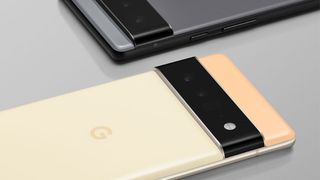New Google Pixel 6 leaks point to ultra-wideband and a Samsung 5G chip
Filling in some blanks

The Google Pixel 6 and Pixel 6 Pro are official, but a lot of the details about them aren't – we still don't know exactly when they'll go on sale, for example. In the meantime, two new leaks have helped to fill in some of the gaps in regards to the specs of the upcoming phones.
First up is a comment from a Google engineer on the Android codebase (via 9to5Google) that mentions ultra-wideband (UWB) support in the Pixel 6. That's the super-precise location-tracking tech that powers devices such as the Apple AirTag and the Samsung Galaxy SmartTag Plus.
It would seem the same tech is coming to the Pixel 6 phones, as has previously been rumored, and some Pixel Tags aren't completely out of the question. Including UWB will help the Pixel 6 and the Pixel 6 Pro keep pace with phones like the Galaxy S21 and the iPhone 12, which also feature ultra-wideband.
- Find the best wireless chargers
- Samsung Galaxy S21 FE leaks and rumors
- Apple could be upgrading Face ID
Choose your 5G
The second rumor is perhaps of more interest to industry watchers rather than end users, but it's worth knowing about: according to Reuters (via Phandroid), the Pixel 6 handsets are going to feature 5G modems manufactured by Samsung. To date, Pixel phones (including the Pixel 5a) have used Qualcomm-made modems for 5G.
On the one hand, this isn't much of a surprise, because we've already heard rumors that Samsung has been working closely with Google on the custom Tensor chipset that's going to power the Pixel 6 and Pixel 6 Pro. It makes sense that other bits of silicon were also part of the discussion.
On the other hand, this is unusual – it's the first time a Samsung 5G chipset has been used in a smartphone not made by Samsung. As soon as we've got our hands on the new phones, we'll tell you how well they perform in terms of next-gen connectivity.
Analysis: the Pixel 6 is shaping up to be a full-on flagship

Google has shied away from troubling the flagship end of the smartphone spectrum with recent Pixel phones, but that's all about to change with the arrival of the Pixel 6 and the Pixel 6 Pro, based on what we know (or think we know) so far.
Get daily insight, inspiration and deals in your inbox
Get the hottest deals available in your inbox plus news, reviews, opinion, analysis and more from the TechRadar team.
With the Pixel 5a available as a more affordable choice (in the US and Japan at least), the Pixel 6 handsets are free to take on the best phones on the market. Google is throwing as much high-end tech as it possibly can at these phones, in a bid to take on the iPhone 13 and the Galaxy S22 over the next six months or so.
Google has made its own custom processor, upgraded the cameras, and given the phones a significant design overhaul as well. Now we're hearing that it's throwing in ultra-wideband as well, and there have obviously been discussions about which 5G components to use as well.
Add the best hardware tech to everything that we know Pixels can do on the software side – produce fantastic photos, perform impressive AI tricks, and more – and the next generation of the phone series is shaping up to be very appealing for those shopping at the flagship end of the market.

Dave is a freelance tech journalist who has been writing about gadgets, apps and the web for more than two decades. Based out of Stockport, England, on TechRadar you'll find him covering news, features and reviews, particularly for phones, tablets and wearables. Working to ensure our breaking news coverage is the best in the business over weekends, David also has bylines at Gizmodo, T3, PopSci and a few other places besides, as well as being many years editing the likes of PC Explorer and The Hardware Handbook.
Most Popular
